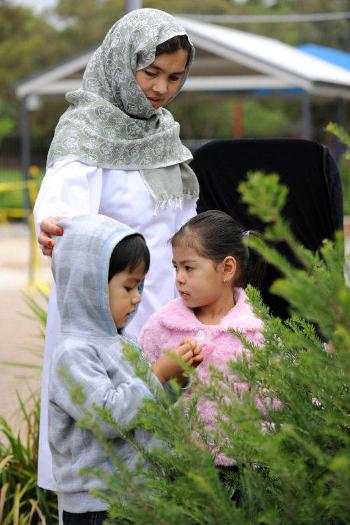What does that feel like?
Duration/age

Have you ever noticed the number of different textures around us?
The rug on the bed can feel soft and cuddly, the new wool jumper might be hard and scratchy and the window after the rain could be cold and slippery.
Next time you are out or moving around the house talk to your child about how things feel.
As you help your child dress you can talk about how the clothing feels. You could try exploring the different textures of food at breakfast time.
Your leggings feel bumpy! I think it is because they are ribbed.
The banana feels slippery and slimy in my mouth but the apple is hard and smooth.
Next time you go for a walk see how many different textures you can find. Try rubbing your hands along the trunk of the tree or touching the middle of the flower to see if it is sticky with pollen. What do the fences feel like? Do they all feel the same?
The brush fence is prickly and scratchy - it feels like the tree.
Materials you will need
- Your hands and fingers
- Your eyes
Skills this activity improves
Why does this matter?
Talking about textures and what you notice helps your child to develop their natural sense of wonder and language to describe what they see.
Talking together about what you have noticed and felt helps your child to ask questions. As they notice objects they can group them and compare the differences. When they talk about what they notice they are developing language to describe their thinking and observations.
When children begin to describe their thinking they have started to hypothesise. When they hypothesise they are beginning to connect what they see to past experiences and use this information to make decisions and reflect on why things have happened.
What does this lead to?
Talking about and exploring the natural and everyday environment with your child will help them to develop the skills to notice, take risks and ask questions. Even if your child does not have a natural disposition to be creative and curious, by exploring and posing questions you are helping your child to experiment with different ways of thinking.
Language to use
- Soft, bumpy, lumpy, cuddly
- Squishy, hard, firm
- Smooth, slippery, prickly, sticky
- Texture, senses, feel, touch
Questions to use
- What does it feel like?
- Can you find anything else that feels the same?
- Can you only feel with your fingers and hands?
Useful tips
- You might also like to take a look at the activities We went walking and On the tram.
- Remember to talk to your child in your home language.
More ideas
- You might like to take a look at 51 things to do before you’re 12.
- Make a texture storybook.
Variation by age
Birth to two year olds
- Borrow stories from the library with different bits for feeling and touching.
- Make a feely bag.
- Create a texture treasure basket.
- Add a range of textured food to your mealtimes.
Three to five year olds
- Borrow stories from the library with different bits for feeling and touching.
- Make a feely bag.
- Create your own texture dominoes.
- Make a texture lotto board to take on your walk.
- When at the greengrocer explore how many different textured fruit and vegetables you can find.
Questions to ask
- What does that feel like?
- Which one feels like the cat?
- Which one feels the same?
Questions to ask
- What does that feel like?
- Which one feels like the cat?
- Which one feels the same?
- Do all trees feel the same?
- Do all leaves feel the same?
- Does cat fur feel different to dog fur?
Language to use
- Feel, touch
- Same, different
- Cat, dog
Language to use
- Feel, touch, hold, texture
- Same, different
- Cat, dog
- Fruit, vegetable


